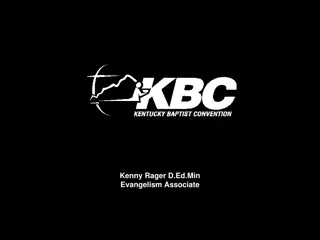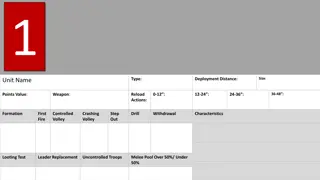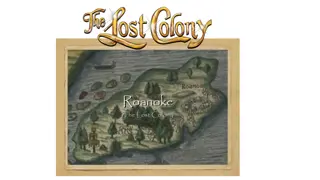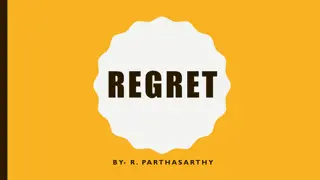Journey to Shangri-La: Lost Horizon Study Unit
The novel Lost Horizon follows the story of four travelers who find themselves in a mysterious valley called Shangri-La. Conway, the protagonist, falls in love with this utopian place while others also experience happiness in staying there. However, not everyone shares the same sentiment, leading to a series of events that test their beliefs and desires. The narrative unfolds with mysteries, amnesia, and a quest for paradise, leaving the characters and readers alike questioning the existence of Shangri-La.
Download Presentation

Please find below an Image/Link to download the presentation.
The content on the website is provided AS IS for your information and personal use only. It may not be sold, licensed, or shared on other websites without obtaining consent from the author.If you encounter any issues during the download, it is possible that the publisher has removed the file from their server.
You are allowed to download the files provided on this website for personal or commercial use, subject to the condition that they are used lawfully. All files are the property of their respective owners.
The content on the website is provided AS IS for your information and personal use only. It may not be sold, licensed, or shared on other websites without obtaining consent from the author.
E N D
Presentation Transcript
Novel Study Unit: LOST HORIZON LOST HORIZON
Lost Horizon Lost Horizon Chapter Summaries
SHORT PLOT / CHAPTER SUMMARY (Synopsis)
SHORT PLOT / CHAPTER SUMMARY (Synopsis) The narrator reads a manuscript written by Rutherford telling the story of four travelers experiences, after being hijacked, in a mysterious valley known as Shangri-La. Conway, the main character of the four, falls in love with the Valley of Blue Moon and eventually is named the new High Lama. Barnard and Miss Brinklow also find happiness in staying there. Only Mallinson desperately wants to leave and his negativity creates an Imbalance there for all the characters. Eventually, Conway agrees to lead him out of the valley, but he is the only one who survives the trip. Then, once he overcomes amnesia, Conway disappears again in a bid to return to the paradise he had come to love. In the end, the narrator and Rutherford come to believe in the existence of Shangri-La and desperately hope that Conway finds his way there again.
Prologue Abstract The story of the LOST HORIZON begins in a social meeting of some old classmates who all knew Hugh Conway while in school. It appears that each of them was more affected by having known Conwaythan they consciously realized.
Prologue The prologue lays down the background to how the narrator comes across a manuscriptwhich reveals something mysterious concerning Conwayand later, Rutherford. There are many strange events connected to Conway: first, the plane that is stolen; second, the Chopin piano piece which no one has ever heard; third, the loss of Conway smemory and its return after he plays the piano; and finally, Conway sstrange story and his stranger decision to catch a boat to Fiji and head northwest. All of these events are foreshadowingfor the manuscript that the narrator is about to read.
Prologue: In Depth Summary The narrator, a neurologist, opens the novel with this prologue; where he explains that he, a writer named Rutherford, an Embassy secretary named Wyland Tertius, and a stranger to the narrator named Sanders, a pleasant young pilot, have all sat down for cigars after dinner at Templelhof. The first three, he says, are three celibate Englishmen in a foreign capital, Berlin. Sanders, who knows Wyland, joins their party after the first three have already dined. They are sitting in the restaurant watching the Luft-Hansa machines arriving at the aerodome and enjoying the evening.
Prologue: In Depth Summary They all drink a great deal of beer, and then Rutherford questions Sanders about his comment that he had been at Baskul and that something interesting had happened there. Sanders tells them that an Afghan or an Afridi had stolen control of one of their planes and taken off in it. The interesting thing about the event was that the thief never came back. There also were three men on board and one woman missionary. One of the men is Glory Conway, a name that Rutherford first mentions. The narrator asks Sanders why it was never in the papers, and Sanders says he has given out more information than he was supposed to, because the event was hushed up.
Prologue: In Depth Summary Wyland had stepped away from the table before Sanders told this information, so when he returns, Sanders reveals what he has said and asks Wyland whether it matters that he said it. Wyland seems somewhat offended that the pilot gave away this information and snubs him a bit. However, he willingly discusses Conway and how Rutherford knew him. Then, they all decide to make it an evening. Rutherford suggests that since the narrator is not leaving until very early in the morning that he spend the time in his hotel. They can talk in his sitting room.
Prologue: In Depth Summary They spend the time discussing Conwaywho had evidently left a significant impression on them both. Rutherfordreveals that he had already heard about the affair at Baskuland had thought it only a myth. He also says that since he has traveled a great deal around the world, he has seen strange things, a comment that confuses the narrator. Then, Rutherford reveals that Conwayisn t dead, because he had traveled with him on a Japanese liner from Shanghai to Honolulu the November before. While he was on the Pekinexpress, he had spoken to a Mother Superior of some French Sisters of Charity. She had mentioned that a fever case had shown up at the mission hospital at Chung- Kiang, a European male with no papers and unable to give any account of himself. He spoke fluent Chinese and French and English with a refined accent. Rutherford had found this hard to believe and politely bid the nun good-bye.
Prologue: In Depth Summary Ironically, he found himself right back at Chung-Kiangwhen the train broke down a mile or two farther on the track. He decided to take the Mother Superior up on her offer to visit her mission. They prepared a meal for him, and a young Chinese Christian doctor sat down with Rutherford. They also took him for a tour of the hospital. When they introduced him to the foreigner she had told him about, he was astonished to discover that the man was Conway. Unfortunately, Conwaydidn t remember Rutherford, because he was suffering from amnesia. Rutherford decided to stay there for a few days to try to help Conwayrecover his memory. He was unsuccessful, but he did make arrangements to take Conwayhome. Once they were on the Japanese liner, Rutherford spent the time telling Conwayas much as he could about his life.
Prologue: In Depth Summary At the port of Yokohama, a new passenger came on board. His name was Sieveking, and he was a concert pianist. He was prevailed upon to give a recital for the passengers with emphasis on Chopin, a musician Sieveking specialized in. After he got up to leave at the end of the recital, Conway sat down at the piano and began to play a rapid, lively piece which drew Sieveking back to the piano in excitement. Conway was unable to tell the pianist what he had been playing, only that he thought it was a Chopin study. Sieveking refused to believe that it was by Chopin, because he knew everything that Chopin had ever written, and he had never heard this piece. Conway then remembered that it had never been published, and that he only knew it himself from meeting a man who had been one of Chopin s pupils. Many witnesses saw this exchange between the two men and heard Sieveking say that the piece was so important as to be a part of every virtuoso s repertoire within six months if it were ever published.
Prologue: In Depth Summary The two men promised to meet again and even made arrangements to make some phonograph records of the piece. Rutherford tells the narrator that he often thought it a pity that Conway was never able to keep his promise to Sieveking. That night after the recital, Conway regained his memory. During the next twenty-four hours, Conway told Rutherford everything that had happened to him, and then they had drinks in Rutherford s cabin about 10:00 PM the night before they were expected to dock in Honolulu. Rutherford never saw Conway again, because he gave him the slip and joined a crew of a banana boat heading south to Fiji. Three months later, Rutherford received a letter from Conway thanking him for his care, paying him for any expenses Rutherford may have incurred, and telling him that he was about to set out on a long journey to the northwest. That was all he said.
Prologue: In Depth Summary The narrator is most confused about how Conway arrived at Chung-Kiang, and how he lost his memory. Rutherford reveals that after Conway had told his story over those twenty-four hours on the Japanese liner, he had written it all down into a manuscript. He brings it out for the narrator and tells him to read it and make of it whatever he will. The narrator asks if he s not supposed to believe it. Rutherford says that Tertullian s phrase quia impossibile est ('I believe because it is impossible\absurd' ) is not a bad argument. Later, Rutherford sends a short note to the narrator saying he was off on his wanderings again would have no settled address for some months. Not surprising to the narrator, Rutherford is heading to Kashmir and then east. Perhaps he believes his own manuscript more than he is willing to admit.
CHAPTER ONE: Notes This is the first part of the manuscript Rutherford had written. It reveals that the rumours about the plane being hijacked were true, and that there were three men and one woman on board, one of whom was Conway. The chapter prepares the reader for a mysterious destination somewhere in the mountains to the northeast. It also shows the reader how Conway becomes the character looked to for help and advice as well as bravery, should it be needed. He is the voice of calm and comfort for the other three passengers. Meanwhile, the pilot remains an unknown element of this equation in which they ve found themselves.
CHAPTER ONE: In Depth Summary The manuscriptbegins by explaining that the situation begins during the third week in May (probably in 1930) in Baskul, Afghanistan, when events become so precarious that British Air Force machines arrive to evacuate the white residents. A miscellaneous aircraft is also employed, one owned by the Maharajah of Chandapore, to evacuate four passengers: Miss Roberta Brinklow of the Eastern Mission; Henry D. Barnard, an American;HughConway, H. M. Consul; and Captain Charles Mallinson, H. M. Vice-Consul. At the time, Conwayis thirty-seven years old and has been at Baskulfor two years. He has no idea where he will be sent next which is a precarious characteristic of his profession as a foreign diplomat. He has been working this profession for ten years. He is so tired at the time of the flight from destroying and packing documents that he stretches out in the plane to sleep.
CHAPTER ONE: In Depth Summary About an hour after the flight began, Mallinsonnotices that the pilot isn t keeping a straight course. He also notices that the pilot isn t Fenner, the man they thought would be flying them out.Conway isn t upset by this possible development, because he isn t all that eager to go to Peshawar. Then, the plane begins to descend, and when the two men look out the window of the plane, they see an opaque mist veiling an immense sun-brown desolation with long, corrugated mountain ridges and frontier scenery. There looks to be no place to land, but the pilot does so into a small space opened by the side of a gully. That is followed by a swarm of bearded, turbaned tribesmen surrounding the machine and preventing anyone from getting out of it except the pilot. The plane is re-fueled, and then the flight commences again. To the four passengers, it is totally extraordinary and bewildering.
CHAPTER ONE: In Depth Summary Mallinsoncomes to the conclusion that they are being kidnapped for ransom which in light of the mysterious events seems the most believable of any theories. Conwaybegins to gather all the scraps of paper he can find to compose a message in as many of the various native languages as he can and then drop them from the plane along the way. It is a slender chance, but one worth taking. Miss Brinklowjust sits tight-lipped and straight-backed, while Conwayand Barnard determine how easy it would have been to hijack the plane. They all agree that if anyone can get them out of this situation it will be Conway. Conwaylies half asleep, turning over in his mind whether he is a brave as his companions have judged him. He has, since WWI, been reluctant to face danger unless it promises extravagant dividends in thrills. He just feels an enormous distaste for whatever trouble might be in store for them.
CHAPTER ONE: In Depth Summary The flight continues all afternoon, steadily eastward, but Conwaycannot judge where they are headed with any accuracy. Mallinsonis eager to smash the panel and demand answers from the pilot, but Conwayreminds him that the pilot is armed, and that none of them will know how to bring down the plane if they hurt him. There is nothing for them to do but sleep, which they all manage to find a way to do. Soon, Conwaybegins to feel the same sensations of shortness of breath that he had experienced once when he had flown in the Swiss Alps. He looks out the window and sees they are flying amidst range upon range of snow-peaks and glaciers.
CHAPTER TWO: In Depth Summary
CHAPTER TWO: In Depth Summary Conwaytells the other passengers as they awaken that they are probably still in India, and that they have probably been flying along some river valley, stretching roughly east and west. If his memory suffices, they are probably in the valley of the upper Indus which would have brought them to this spectacular part of the world. He also thinks the mountain they are looking at is probably Nanga Parbat and the range is the Karakorams. He knows there are several passes through these mountains if the pilot intends for them to cross them. Mallinsoninsists that the kidnapping theory is no longer applicable, because there are no tribes this far that would seek a ransom. Now the purpose of this flight becomes once again even more frightening. Conwayhas no answers for their fears, but is secretly satisfied that there are still such beautiful places on earth.
CHAPTER TWO: In Depth Summary Dusk soon falls which lowers their spirits once again, and Conwaycomes to the conclusion that they are heading towards Tibet. Soon, the plane gives a lurch, and they realize that the engines have been turned off, and the plane is rushing against a gale. The pilotthen lands the plane badly with crashing and swaying jolts to the passengers and a broken tail-skid. They tear open the cockpit and discover the pilotis unconscious. Conwayassumes finally the strong role of the leader, and they lift the man out and down to the ground. Then, they realize that the environment will be dangerous for them all and return the pilot and themselves to the cabin of the plane. Miss Brinklowsurprisingly produces a bottle of brandy, and they give the pilotsome.
CHAPTER TWO: In Depth Summary Conwaynow believes that they have flown far beyond the western range of the Himalayastowards the less known heights of the Kuen-Lun. They have reached the loftiest and most inhospitable part of the earth s surface, the Tibetanplateau. The next day, they take the pilotout of the plane, hoping the sun will revive him, but he becomes weaker and finally dies about mid-morning. The man muttered in his final delirium enough information to let them know that they were in Tibet, and that there is a lamaserynearby called Shangri-la. The dying man had been very emphatic that they go there. They argue about whether this is the best plan for them to follow, but finally come to the conclusion that their best chance of survival is to find humans. Just as they finally all agree to the plan, they see coming down a faraway slope the figures of men.
CHAPTER THREE: Notes Much of this chapter is a series of foreshadowing: Conway preferring not to be a leader, but accepting the role anyway; Chang, a Chinese, who speaks perfect English; Chang scomments that they may not be away from civilization at all and that they will ultimately have no regrets about coming to Shangri- La; seeing a new mountain, Karakal; Conway s feeling that he has at last found a place which is an end, a finality; and Chang s explanation for his nap that he has to take care of himself. All of these events indicate that Shangri-Lais a mysterious unknown place that will bring all four of these captives to discover a world that may or may not bring them peace and happiness.
CHAPTER THREE: In Depth Summary As the four passengers await the arrival of the men in the distance, Conway takes on the role of onlooker, refusing to be drawn into being a leader or being forced to decide what to do or not to do. Then, the figures reveal themselves to be a part of a dozen or more men carrying with them a hooded chair. Inside the chair is a figure robed in blue. Having lived in China for a few years, Conway understands the ritual of meeting and how ceremonial it must be. As a result, he steps forward to follow the proper procedure, and the stranger follows suit and says he is from the lamasery of Shangri-Laand his name is Chang. He speaks perfect English and insists that he guide them back to the lamasery. Conway agrees, but Mallinsoninsists that their stay won t be long, because they want to return to civilization as soon possible. Chang responds, Are you so very sure that you are away from it? It is a significant comment foreshadowing the future. He further declares that the four passengers will be honorably treated, and that ultimately, they will have no regrets.
CHAPTER THREE: In Depth Summary Changthen sees to it that they have wine and mangoes, a fruit that Conwaycannot believe could be cultivated so high in the mountains. Once they are refreshed, the party begins its climb towards the lamasery, viewing a mountain that Conwayhas never heard of before Karakal in the distance. Conwaywonders if the lamas have surveyed its height, and Changonly comments that there s nothing incompatible between monasticismand trigonometry.
CHAPTER THREE: In Depth Summary They walk all morning and into the afternoon, with the air becoming thinner and harder to breathe, while Changesleeps in his chair. They eventually reach the summit of the ridge and then link themselves together with heavy mountaineering ropes in order to be protected as they follow a track consisting of a traverse cut along the flank of a rock wall. The height above it is obscured by the mist, and below is an abyss. Meanwhile, most of the way on this track, Mallinsonis begging Conwayto decide what they are going to do. Conwayreplies that there are times in life when the most comfortable thing is to do nothing at all. He reminds the younger man that they may have just exchanged one lunacy for another, given that they have just escaped the torturous nightmare of Afghanistan.
CHAPTER THREE: In Depth Summary Suddenly, being first of the four passengers, Conwaysees the lamasery appear out of the mist. It is absolutely superb and exquisite, seeming to hang on the side of the next ridge. Meanwhile, in the valley below, is a delightfully flavored place awash in green. He feels the deeper sensation, half mystical, half visual, of having reached at last some place that is an end, a finality. Changthen awakes and makes the mysterious comment that he has slept, because he has to take care of himself. He indicates that they will be given the opportunity to bathe and refresh themselves, and then he will be honored if they all join him for dinner. Mallinsonagrees, but only if Changwill help them make plans for their departure.
CHAPTER FOUR: Notes This chapter is basically a study in the determination of Mallinsonto depart from Shangri-La and Conway s growing fascination with the lamasery. One represents the frustration and the impetuous demands of youthwhile the other is a study in patience and complacency and even a desire to just find some peace in his life. These two contrasting characters will be the ultimate determiners of the outcome of this story and the lessonsthe reader will learn in the end: one being fear of the unknown and the other, the search for a meaningful life.
CHAPTER FOUR: In Depth Summary Later that evening as they are all seated at dinner, Chang observes that they are not as uncivilized as the four may have expected. Conwayis unable to deny it as he had noticed at his bath that the tub is made of delicate green porcelain made in Akron, Ohio. He readily enjoys the meal, because he likes the Chinese and their ways. Changeats only a salad and once again explains his behaviour by commenting that he must take care of himself. Conwaycomments in return that the lamas seem a very fortunate community, and hospitable to strangers. He observes that they must not receive strangers very often, and that a separate culture might flourish there without contamination from the outside world.
CHAPTER FOUR: In Depth Summary Miss Brinklow speaks up and assertively asks Changto tell them about the monastery. In his ensuing commentary, the reader discovers that there are fifty who are considered full lamas and a few others, including himself, who have not yet obtained full initiation, an amazing piece of information, given thathe seems to be elderly although not yet old. He also explains that there are representatives among them from a great many nations, although Tibetans and Chinese make up the majority. When Miss Brinklow, in her missionary attitude, asks him to explain what the lamas believe, he explains that there are many religious beliefs among them, but what they most believe in is moderation. They avoid excesses of all kinds in the valley. Conway observes that Changapplies the idea of moderation to the people of the valley, but is careful not to apply it to the priesthood. When he asks Chang why, the elder man replies that it is a matter which he may not discuss, another mysterious comment about life at the lamasery.
CHAPTER FOUR: In Depth Summary Mallinsoncontinues to question Changabout arranging for porters to lead them out as early as the next day. But Changsays that he is not the proper person to approach about the matter, and that he doesn t believe the matter can be arranged immediately. Mallinsoncontinues to press the point, trying to get Changto help them, while Changis readily amenable to anything Mallinsonasks for, including maps, but is short of agreeing to make the arrangements. Changeventually gets to the point where he just doesn t answer Mallinson, and the young man, in his anger and anxiety, collapses. Chang blames his collapse on the thin air and insists he will better the next day.
CHAPTER FOUR: In Depth Summary Conwaythen steps forward to patiently encourage Changto answer Mallinson squestions. Because he is so patient and less demanding, Changobserves that he is wiser than his companions and explains that they will not be able to hire men from the valley to be their porters, because they will refuse to leave the valley. Conwayalso observes to Changthat it was not a chance meeting when Changand the men had come across their plane and that they must have known beforehand about their arrival. He wonders how? For a moment, Changshows stress, something that Conwayhad not noticed before. He insists to Conwaythat none of them are in any danger at Shangri-La, but they may have to face some delay in their departure. Conwayis agreeable to a short delay, because he feels so comfortable at the lamasery. As Changmoves to depart from the dinner table, Conwayasks him the literal interpretation of Karakal. Changwhispers that it means Blue Moon.
CHAPTER FOUR: In Depth Summary When morning comes, Conwaymuses on his role at the lamasery now. He thinks about his position as a leader who had safely evacuated the British personnel from Baskul. He feels that it is not a bad achievement, and that gives him comfort. However, he does have some slight worry about whether the others can achieve their departure, given the strangeness of this place. As for himself, the puzzle of Shangri-Lais beginning to exercise over him a charming fascination. He is far from grumbling about their situation.
CHAPTER FOUR: In Depth Summary When Mallinson once again inquires of Changabout porters, Chang tells him what he had told Conway the night before: there are no men willing to accompany the group so far from their homes. Conway smoothly intercedes again to avoid any ugliness by asking Changwhat he proposes they do. Changseems to be willing to answer Conway just about anything and offers the suggestion that they wait approximately a month or two for delivery men expected at the time. He thinks they will be willing to take the four with them on their return journey. Of course, he offers no exact date, claiming they never know exactly when a delivery will occur. But he insists again that the lamasery will continue to offer its utmost hospitality. This information infuriates Mallinson, but Conway restrains the younger man in order that he not insult Chang.
CHAPTER FIVE: Notes This chapter is devoted to the four travelers coming to terms with their predicament. Mallinson has given in to the thought of a two month stay, Barnard feels their loss will not affect him at all, and Miss Brinklow sums it all up to the mysterious force of Providence. Conway is happy there and is content to solve the puzzle of their arrival in Shangri-La. He is wiser than the other three and soon comes to some important conclusions about the flight there, and how it obviously had been planned. Now he is eager to learn why.
CHAPTER FIVE: In Depth Summary For the remainder of the morning, the four discuss the matter of leaving the lamasery. Mallinsonis somewhat mollified and more accepting of their fate, but still determined to leave this strange place that he labels crooked. Conwayis the voice of reason, logically deciding that it can t be any worse than two months in any other isolated part of the world. Miss Brinklowis fatalistic, saying that she has been called to the Lord s service and is agreeable to whatever Providence brings her. Barnard, the American, isn t the least concerned about their being posted as missing, because he doesn t believe that affects him one way or another, a puzzling statement to say the least.
CHAPTER FIVE: In Depth Summary Conwaythen remarks that the first rule of their stay must be to avoid getting on each other s nerves. The others agree, and then they observe that it will at least be comfortable there, even if it is a mystery. Changenters after a while and offers to guide them on a tour of the lamasery while Mallinson and Miss Brinklow comment that they never thought they d end up in a place like this nor why they have.
CHAPTER FIVE: In Depth Summary The grand tour is an interesting moment for them all. Conwayis becoming even further enchanted with the rich amenities of the place. There is a delightful library, filled with the world s best literature and hundreds of maps of the area, although Changcomments that they will not find Shangri-La on any of them. Miss Brinklowwonders if they will see the lamas at work, but Changreplies that her request is impossible as they are very rarely seen outside the lamahood. When she asks what they do, Changsays that they devote themselves to contemplation and to the pursuit of wisdom. To Miss Brinklow, that s doing nothing.
CHAPTER FIVE: In Depth Summary Then, they follow Changthrough several courtyards to come upon a scene of unmatched loveliness. It is an open pavilion fringing a lotus pool surrounded by sculptures of lions, dragons and unicorns. In the pavilion are a harpsichord and a modern grand piano. This pavilion inspires comments and questions about the lamas love of western music and the fact that they might someday order a phonograph delivered to the lamasery. For now, there is no need for them to hurry in this request. Barnardobserves that No hurry must be the slogan of the lamas. When he then questions Changabout how they pay for all this, Changagain closes up and refuses to answer. Conwaysees this as once again edging the visible border-line between what might and what might not be revealed.
CHAPTER FIVE: In Depth Summary At this point, an agile, lithe-limbed Chinese girl appears and plays the harpsichord. Conwayis fascinated by her and realizes that she is a Manchu. Changsays her name is Lo-Tsen, and like Chang, she has not yet achieved full initiation. He says there are no sex distinctions among the lamas. However, when Conwayasks her age, Changonce again says he cannot tell him. Later that evening, after dinner, Conwaystrolls into the moon-lit courtyards and as he gazes on Karakal, he realizes he is physically happy, emotionally content, and mentally at ease. He is puzzled by Shangri-La, but even though he cannot understand it yet, he feels it will somehow be understood eventually. Then, he hears sounds from far below in the valley.
CHAPTER FIVE: In Depth Summary Using his understanding of the Chinese language which is near in structure to the Tibetan language, he realizes that the people in the valley are burying Talu, the man who had hijacked their plane and flown it into the valley. Now Conwayknows for sure that their flight was not a meaningless exploit of an insane man. It had been planned, prepared and carried out at the instigation of the lamasery. The question still is: what is the purpose of their being brought to Shangri-La? He decides that his discovery, however, must not be communicated to the other three of his group, who could not help him solve the puzzle, nor to their hosts, who probably would not help him.
CHAPTER SIX: Notes This chapter helps the reader understand how three of the travelers are coming to love the lamasery and the valley. Only Mallinson is still discontented and wants badly to go home. Conway is more and more at home and has many wise and interesting conversations with Chang. He is impressed with the life there, fascinated by the mystery behind it, and reluctant to leave. He has even impressed the lamas as seen in his unprecedented invitation to speak to the HighLama. Now he will begin to learn the truth behind the travelers arrival at Shangri-La.
CHAPTER SIX: In Depth Summary By the end of the first week, the group has settled into somewhat of a routine. Chang is tireless in his efforts to smooth all their rough spots. He even allows them access to the valley. Conway finds it nothing less than an enclosed paradise, spanning the whole gulf between temperate and tropical. The people are a blend of Tibetan and Chinese and are clean and handsome as well as hospitable. It is one of the pleasantest communities he s ever seen. Miss Brinklowsees it as an opportunity to begin a mission among these people and to that end, she asks Chang for a book so she can study and learn the language.













![101 Reviews How to Recover Lost Bitcoin [Scammed/Stolen Funds]](/thumb/153354/101-reviews-how-to-recover-lost-bitcoin-scammed-stolen-funds.jpg)








